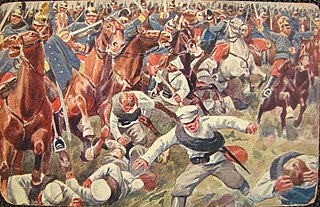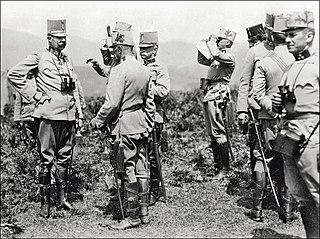
The Brusilov offensive, also known as the June advance, or Battle of Galicia-Volhynia, of June to September 1916 was the Russian Empire's greatest feat of arms during World War I, and among the most lethal offensives in world history. The historian Graydon Tunstall called the Brusilov offensive the worst crisis of World War I for Austria-Hungary and the Triple Entente's greatest victory, but it came at a tremendous loss of life. It was arguably the most successful offensive in the entirety of the First World War. The victory contributed to a morale upsurge among the Russian troops, in 1917, Nicholas II planned a general offensive along the entire front in order to end the Central Powers. After the victory, the Petrograd conference was held at which the post-war structure of the world was discussed. Even despite the losses, the Russian armies were still being reinforced with new forces, the number of weapons increased, and new railways were being built. The result of the battle will fully restore Russia's prestige among the allies, which forced them to make serious territorial concessions, such as Anatolia and Constantinople, the French government confirmed the possibility of the Russians themselves to choose which territories to tear away from Germany after the war.

Eduard Freiherr von Böhm-Ermolli was an Austrian general during World War I who rose to the rank of field marshal in the Austro-Hungarian Army. He was the head of the Second Army and fought mainly on the front of Galicia during the entire conflict. On 30 October 1940, Böhm-Ermolli was made a German Generalfeldmarschall.

The siege of Przemyśl was the longest siege in Europe during the First World War. The siege was a crushing defeat of the Austro-Hungarian Army by the Russian Army. Przemyśl was a fortress-town and stronghold on the River San in what is now southeastern Poland. The investment of Przemyśl began on 16 September 1914 and was briefly suspended on 11 October, due to an Austro-Hungarian offensive. The siege resumed again on 9 November and the Austro-Hungarian garrison surrendered on 22 March 1915, after holding out for a total of 133 days. The siege has been referred to as "Austria-Hungary's Stalingrad".

The Austro-Hungarian Army, also known as the Imperial and Royal Army, was the principal ground force of Austria-Hungary from 1867 to 1918. It consisted of three organisations: the Common Army, the Imperial-Royal Landwehr and the Royal Hungarian Honvéd.

The 1st Army was a field army-level command in the ground forces of Austria-Hungary during World War I. The army fought in Galicia and Russian Poland in 1914–15 before being briefly dissolved in the summer of 1916. Shortly afterwards, it was reformed and sent to fight in the Romanian Campaign for the next two years. The 1st Army was demobilized in April 1918 due to its heavy losses, following Romania's surrender.

The Battle of Galicia, also known as the Great Battle of Galicia, was a major battle between Russia and Austria-Hungary during the early stages of World War I in 1914. In the course of the battle, the Austro-Hungarian armies were severely defeated and forced out of Galicia, while the Russians captured Lemberg and, for approximately nine months, ruled Eastern Galicia until their defeat at Gorlice and Tarnów.

The Battle of the Vistula River, also known as the Battle of Warsaw and Ivangorod, was a major Russian victory against the German Empire and Austria-Hungary on the Eastern Front during the First World War.

The Battle of Kraśnik(German: Schlacht von Kraśnik) started on August 23, 1914, in the province of Galicia and the adjacent areas across the border in the Russian Empire, in northern Austria, and ended two days later. The Austro-Hungarian First Army defeated the Russian Fourth Army. It was the first victory by Austria-Hungary in World War I. As a result, the First Army's commander, General Viktor Dankl, was (briefly) lauded as a national hero for his success. The battle was also the first of a series of engagements between Austria-Hungary and Russia all along the Galicia front.

The Gorlice–Tarnów offensive during World War I was initially conceived as a minor German offensive to relieve Russian pressure on the Austro-Hungarians to their south on the Eastern Front, but resulted in the Central Powers' chief offensive effort of 1915, causing the total collapse of the Russian lines and their retreat far into Russia. The continued series of actions lasted the majority of the campaigning season for 1915, starting in early May and only ending due to bad weather in October.

The Rovno offensive — the operation of the Austro-Hungarian Northern armies against the armies of the Russian Southwestern Front — the so-called campaign on Rovno, or Lutsk-Rovno offensive operation. The purpose of the offensive was the liberation of Eastern Galicia, but by the end of the operation, a small part of Eastern Galicia was still held by the Russian Imperial Army.

The Battle of Komarow was a battle on the Eastern Front during World War I. It would prove a victory for the Austro-Hungarian forces, but one they would not be able to reproduce in the coming months of the war.

Paul Freiherr Puhallo von Brlog was a general of Austria-Hungary. During World War I, he commanded the Austro-Hungarian Army's 3rd and 1st Armies.

Together with the Dragoons and Hussars, the Imperial and Royal Uhlans, made up the cavalry of the Austro-Hungarian Army from 1867 to 1918, both in the Common Army and in the Austrian Landwehr, where they were known as the Imperial-Royal Landwehr Uhlans.

The leaders of the Central Powers of World War I were the political or military figures who commanded or supported the Central Powers.
The 3rd Army was a field army-level command within the ground forces of Austria-Hungary during World War I. It was primarily active on the Eastern Front against the Russian Empire and in the Balkans against Serbia and Montenegro. Later on, the 3rd Army took part in some fighting on the Italian Front before returning to the eastern theater by 1917 to repulse the Kerensky Offensive. Its remaining units were merged with the 7th Army in January 1918.

Artur Edler von Mecenseffy was an Austro-Hungarian Army officer who held the rank of Feldmarschall-leutnant and served during World War I, becoming the highest-ranking officer of Austria-Hungary to be killed on the battlefield.

The Carpathian Front, sometimes referred to as the Carpathian Winter War of 1915 was one of the largest military operations on the Eastern Front in terms of scale, duration, the number of troops involved in it and the losses of the parties.

The Balkanstreitkräfte, also known as the Balkan Army, was the force raised by Austria-Hungary for its offensive action against Serbia in August 1914, at the start of World War I.

Ludwig Goiginger was an Austro-Hungarian Lieutenant Field Marshal who notably served in World War I.

Andreas Karl Franz Fail, from 1875 Fail-Griessler was an Austro-Hungarian General of Infantry. He was born 25 February 1857 in Graz and died 6 March 1919 in Graz. At the beginning of the First World War he was commander of the 32nd Infantry Troop Division in Syrmia during the Serbian campaign, then from September to November 1914 commanding general of the VII Army Corps, which during this time was deployed with the k.u.k. 2nd and 3rd Armies at the Carpathians.



















